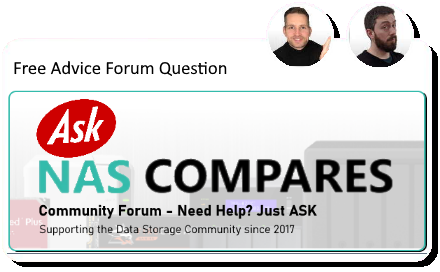02-28-2025, 12:34 PM
Thanks for your kind words and for watching the videos!
With your setup on the QNAP TS-462, you're off to a solid start. Here's a breakdown of your questions:
Should you add NVMe as a cache? While adding NVMe as a cache can improve read/write speeds, for your use case with a 1000-movie and 100-show library, it's likely not a significant necessity unless you're dealing with high concurrency or heavy transcoding. For Plex, if your library isn't overly large and you aren't frequently transcoding 4K content on the fly, an NVMe cache might not provide the performance boost you're expecting.
Should you use an SSD partition to install Plex software and DB? Yes, this is a solid idea. Installing Plex on an SSD partition and storing your media on the HDDs can help with faster database access and improved application performance. The Plex software and metadata can benefit from the SSD's speed, while your media can remain on the larger capacity HDDs.
The QNAP NAS allows you to configure the storage volumes separately, so you can install Plex on the SSD partition while keeping your media on the HDDs. You'll have full control over this setup, so it’s entirely possible.
So, to summarize:
Cache: Optional, but might not provide a noticeable benefit for your library size.
SSD Partition for Plex: A good move for performance, especially for Plex's database and application files.
With your setup on the QNAP TS-462, you're off to a solid start. Here's a breakdown of your questions:
Should you add NVMe as a cache? While adding NVMe as a cache can improve read/write speeds, for your use case with a 1000-movie and 100-show library, it's likely not a significant necessity unless you're dealing with high concurrency or heavy transcoding. For Plex, if your library isn't overly large and you aren't frequently transcoding 4K content on the fly, an NVMe cache might not provide the performance boost you're expecting.
Should you use an SSD partition to install Plex software and DB? Yes, this is a solid idea. Installing Plex on an SSD partition and storing your media on the HDDs can help with faster database access and improved application performance. The Plex software and metadata can benefit from the SSD's speed, while your media can remain on the larger capacity HDDs.
The QNAP NAS allows you to configure the storage volumes separately, so you can install Plex on the SSD partition while keeping your media on the HDDs. You'll have full control over this setup, so it’s entirely possible.
So, to summarize:
Cache: Optional, but might not provide a noticeable benefit for your library size.
SSD Partition for Plex: A good move for performance, especially for Plex's database and application files.





